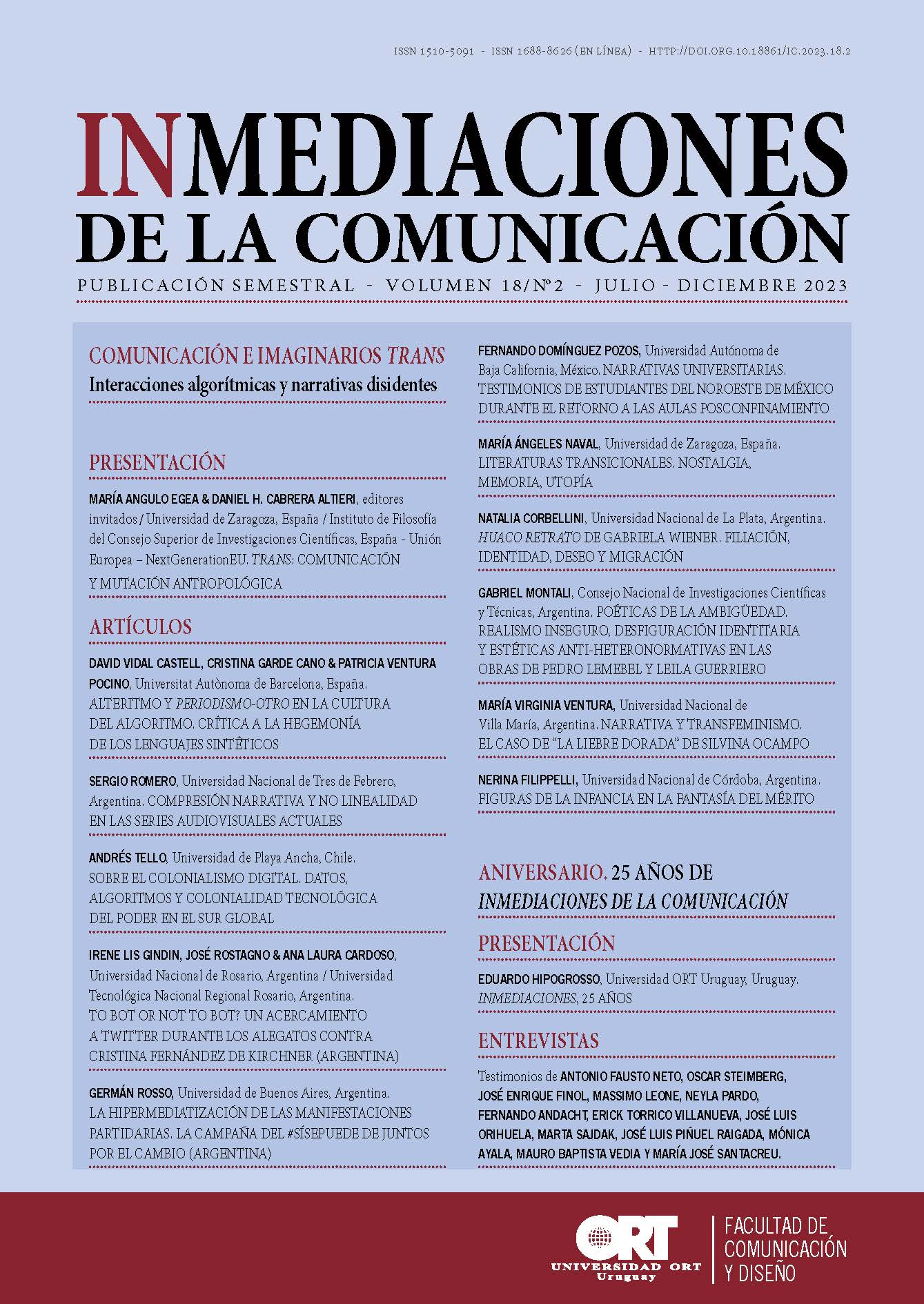To bot or not to bot?
An approach to Twitter during the allegations against Cristina Fernández de Kirchner (Argentina, 2022)
DOI:
https://doi.org/10.18861/ic.2023.18.2.3524Keywords:
semiodata, Twitter, bot, sense, circulationAbstract
The article analyzes, from the perspective of semiodata and the semiotics of mediations, the circulation of meaning around an event of great political relevance for Argentina: the allegations in one of the corruption cases against the current vice president Cristina Fernández de Kirchner –cause commonly known as “Roads” or “Public Works”–. With the aim of describing this flow of meaning, we analyze the exchanges produced on the Twitter media platform. What flows and counterflows can we observe on Twitter? What were the prevailing hashtags? What role do fake accounts play in these cases? The study was carried out based on the collection of tweets produced in Argentina from July 27 to August 23, 2022, period in which the accusatory hearings took place. The recollection was carried out from certain preselected keywords and hashtags, a task that was carried out by means of a small script using the Python programming language in conjunction with the free software library called Tweepy, which allows you to connect to Twitter and listen to the posted tweets in real time. The results we arrived at led us to use a model that could identify fake accounts and allow us to know the impact they had on public discussion.
Downloads
References
Carlón, M. (2020). Circulación del sentido y construcción de colectivos en una sociedad hipermediatizada. San Luis: Nueva Editorial Universitaria.
Carlón, M. (2021a). El poder del humor en una sociedad hipermediatizada. Recursos estilísticos y saltos hipermediáticos En Burkart, M., Fraticelli, D. & Várnagy, T. (coordinadores), Arruinando chistes. Panorama de los estudios del humor y lo cómico (pp. 129-149). Buenos Aires: Teseo Press.
Carlón, M. (2021b). ¿El fin de la retransmisión de la historia? Archivo del Seminario Lo Contemporáneo. Con/desde América Latina. Recuperado de: https://www.youtube.com/watch?v=d8dRPZQqWfo&ab_channel=SeminarioLoContempor%C3%A1neo
Coiutti, N., Gindin, I., Castro Rojas, S., Cardoso, A. L. & Rostagno J. (2019). Twitter, medios masivos y acción colectiva en el caso #RosarioSangra. En Fernández, M., Sánchez, S., Cingolani, G. & Fernández, J. L. (2019). Mediatizaciones, Territorios y Segmentaciones (pp. 192-212). Rosario: UNR Editora.
Díaz Ordoñez, V., Solki, J. P. & Taraborrelli, D. (2020). Construcción de acontecimientos en Twitter: la apertura de sesiones ordinarias de Argentina en el 2020. Anais de Artigos IV Seminário Internacional de Pesquisas em Midiatização e Processos Sociais, 4(1), 1-11.
Fernández, J. L. (2016). Plataformas mediáticas y niveles de análisis. InMediaciones de la Comunicación, 11, 71-96. Recuperado de: https://revistas.ort.edu.uy/inmediaciones-de-la-comunicacion/article/view/2618
Ganzaba, M. & Mendieta Bartolomé, A. (2020). La guerra civil en Twitter. Análisis del uso de bots para una nueva narrativa multimedia. En Meso Ayerdi, K., Peña Fernández, S. & Larrondo Ureta, A. (coordinadores), Nuevos actores y estrategias en
el espacio mediático compartido (pp. 99-114). Bilbao: Universidad del País Vasco.
Gindin, I. (2021). Cristina Fernández y el Poder Judicial: apuntes sobre un vínculo discursivo conflictivo. Revista Mexicana de Opinión Pública, 30, 59-73. DOI: https://doi.org/10.22201/fcpys.24484911e.2021.30.71082
Gindin, I. (2022). El poder judicial en discurso. Controversias en la presentación del Proyecto de Democratización de la Justicia en Argentina. Revista Discursos del Sur, 8, 173-194. DOI: https://doi.org/10.15381/dds.n8.21302
Gindin, I., Castro Rojas, S., Coiutti, N., Cardoso, A. L. & Rostagno, J. (2019). Emoción en acción. El caso de #RosarioSangra en Twitter (Rosario, Argentina, 2016). Ámbitos. Revista Internacional de Comunicación, 43(1), 48-69. DOI: https://doi.org/10.12795/Ambitos.2019.i43.03
Gindin, I., Castro Rojas, S., Coiutti, N., Cardoso, A. L., Rostagno, J. & Brussa, V. (2018). Twitter como laboratorio de opiniones: #RosarioSangra, el paso de la emoción a la acción. Ponencia, Coloquio Anual del Centro de Investigaciones en Mediatizaciones: “Mediatizaciones, territorios y segmentaciones”, Universidad de Buenos Aires, Argentina.
Gindin, I., Rostagno, J. & Cardoso, A. L. (2022). La construcción de un acontecimiento contemporáneo: flujos de sentido y combinación metodológica en los alegatos contra Cristina Fernández de Kirchner (Argentina, 2022). Ponencia, XV Congreso Nacional y VIII Internacional sobre Democracia, Universidad Nacional de Rosario, Argentina.
Kollmann, R. (2022). Juicio contra Cristina Kirchner: Los partidos de fútbol del fiscal Luciani y el juez Giménez Uriburu en la quinta de Macri. Página 12. Recuperado de: https://www.pagina12.com.ar/447454-juicio-contra-cristina-kirchner-los-partidos-de-futbol-del-f
Leavitt, A. (2014). From #FollowFriday to YOLO: Exploring the Cultural Salience of Twitter Memes. En Weller, K., Bruns, A., Burgess, J., Mahrt, M. & Puschmann, C. (Eds.), Twitter and society (Digital Formations, 89). New York: P. Lang. Recuperado de: https://nbn-resolving.org/urn:nbn:de:0168-ssoar-47764-2
Raimondo Anselmino, N., Rostagno, J. & Cardoso, A. L. (2021). Aplicación de técnicas de clustering para el estudio sociosemiótico sobre géneros periodísticos en fanpages de Clarín y La Nación. Revista del prudente saber y el máximo posible de sabor, 14. 77-103.
Verón, E. (1987). Prefacio. En Construir el acontecimiento. Los medios de comunicación masiva y el accidente en la central nuclear de Three Mile Island (pp. 3-10). Buenos Aires: Gedisa.
Wright, J. & Anise, O. (2018). Don’t @ Me: Hunting Twitter Bots at Scale. Presentation, Black Hat USA 2018, Las Vegas, United State.






